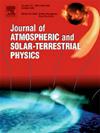Interpretable artificial intelligence models for predicting lightning prone to inducing forest fires
IF 1.8
4区 地球科学
Q3 GEOCHEMISTRY & GEOPHYSICS
Journal of Atmospheric and Solar-Terrestrial Physics
Pub Date : 2025-02-01
DOI:10.1016/j.jastp.2024.106408
引用次数: 0
Abstract
Specific types and intensities of lightning are significant causes of forest lightning fires. Analyzing the relationship between these lightning events and the climatic conditions that favor their occurrence is crucial for predicting and preventing forest lightning fires. However, there is a lack of research in this area for the Greater Khingan Range in Northeast China. This study utilized data from three lightning location networks and the ERA5 meteorological dataset to analyze the historical climate and lightning data in the Greater Khingan Mountains region of China from 2021 to 2023, focusing on the impact of various climatic factors on the density of target lightning—lightning that is prone to cause forest lightning fires. Four machine learning models—SVM, RF, XGBoost, and LightGBM—were evaluated, with RF demonstrating the best predictive performance, achieving R2 of 0.83, MAE of 1.91, and MSE of 14.90. Additionally, the prediction results of the RF model were evaluated using the Kruskal-Wallis test to determine if the results are statistically significant. Using SHAP values to interpret the model, it was found that the K-index (kx) and Convective Available Potential Energy (CAPE) are the most significant predictors of target lightning density, followed by the leaf area index for high vegetation (lai_kv), surface pressure (sp), cloud base height (cbh), temperature at 2 m (t2m), and coverage of high vegetation (cvh). Approximately 70% of the total average absolute SHAP values are attributed to kx and CAPE, highlighting their crucial role in the prediction process. This study provides insights into the environmental factors influencing lightning frequency and emphasizes the importance of interpretable machine learning models in predicting future lightning occurrences and forest lightning fires. Visualization tools, including SHAP summary plots and force plots, were used to provide a detailed illustration of each feature's contribution to the model predictions.
用于预测容易诱发森林火灾的闪电的可解释人工智能模型
闪电的特定类型和强度是引起森林雷击火灾的重要原因。分析这些闪电事件与有利于其发生的气候条件之间的关系对于预测和预防森林闪电火灾至关重要。然而,对于东北大兴安岭,这方面的研究还比较缺乏。利用3个闪电定位网数据和ERA5气象数据集,分析了2021 - 2023年中国大兴安岭地区历史气候和闪电数据,重点研究了各种气候因子对易引发森林闪电火灾的目标闪电密度的影响。对svm、RF、XGBoost和lightgbm四种机器学习模型进行了评估,其中RF表现出最好的预测性能,R2为0.83,MAE为1.91,MSE为14.90。此外,使用Kruskal-Wallis检验对RF模型的预测结果进行评估,以确定结果是否具有统计学意义。利用SHAP值对模型进行解释,发现k指数(kx)和对流有效势能(CAPE)是目标闪电密度最显著的预测因子,其次是高植被叶面积指数(lai_kv)、地表压力(sp)、云底高度(cbh)、2m温度(t2m)和高植被覆盖度(cvh)。大约70%的总平均绝对SHAP值归因于kx和CAPE,突出了它们在预测过程中的关键作用。这项研究提供了影响闪电频率的环境因素的见解,并强调了可解释的机器学习模型在预测未来闪电发生和森林闪电火灾中的重要性。可视化工具,包括SHAP总结图和力图,被用来提供每个特征对模型预测的贡献的详细说明。
本文章由计算机程序翻译,如有差异,请以英文原文为准。
求助全文
约1分钟内获得全文
求助全文
来源期刊

Journal of Atmospheric and Solar-Terrestrial Physics
地学-地球化学与地球物理
CiteScore
4.10
自引率
5.30%
发文量
95
审稿时长
6 months
期刊介绍:
The Journal of Atmospheric and Solar-Terrestrial Physics (JASTP) is an international journal concerned with the inter-disciplinary science of the Earth''s atmospheric and space environment, especially the highly varied and highly variable physical phenomena that occur in this natural laboratory and the processes that couple them.
The journal covers the physical processes operating in the troposphere, stratosphere, mesosphere, thermosphere, ionosphere, magnetosphere, the Sun, interplanetary medium, and heliosphere. Phenomena occurring in other "spheres", solar influences on climate, and supporting laboratory measurements are also considered. The journal deals especially with the coupling between the different regions.
Solar flares, coronal mass ejections, and other energetic events on the Sun create interesting and important perturbations in the near-Earth space environment. The physics of such "space weather" is central to the Journal of Atmospheric and Solar-Terrestrial Physics and the journal welcomes papers that lead in the direction of a predictive understanding of the coupled system. Regarding the upper atmosphere, the subjects of aeronomy, geomagnetism and geoelectricity, auroral phenomena, radio wave propagation, and plasma instabilities, are examples within the broad field of solar-terrestrial physics which emphasise the energy exchange between the solar wind, the magnetospheric and ionospheric plasmas, and the neutral gas. In the lower atmosphere, topics covered range from mesoscale to global scale dynamics, to atmospheric electricity, lightning and its effects, and to anthropogenic changes.
 求助内容:
求助内容: 应助结果提醒方式:
应助结果提醒方式:


